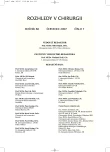Surgical Management of Intrahepatic Cholelithiasis – Two Case Reviews
Authors:
V. Visokai; L. Lipská; P. Záruba; J. Rotnágl
Authors‘ workplace:
Chirurgická klinika FTN Praha a 1. LF UK, přednosta: doc. MUDr. V. Visokai, Ph. D.
Published in:
Rozhl. Chir., 2007, roč. 86, č. 7, s. 370-375.
Category:
Monothematic special - Original
Overview
Introduction:
Intrahepatic lithiasis (IHL) has a low incidence rate in countries with high social-economical level, with mostly secondary ethiology. The commonest signs include: cholangoitis, obstruction icterus, liver absces and secondary biliary cirrhosis. Although a wide range of treatment methods is available, in some cases, surgical management is the only alternative.
Methods:
The authors present two case reviews of IHL patients. The first case includes a 56-year old male, unsuccessfuly operated in another clinic. The patient was referred to the author’s clinic for a relaps of septic complications. He underwent extensive revision of his bile ducts up to the segmental bile duct level with a mechanical removal of concrements, introduction of the T-drain and postoperative cholangiography for secondary IHL of the left hepatic duct. A resection procedure was not indicated due to absence of the liver parenchyma impairment. The other patient, a 77-year old male, underwent left lateral bisegmentectomy for a primary IHL of the SII and SIII liver segments with signs of irreversible bile duct impairment, which could not be managed endoscopically.
Results:
No complications during the first patient’s postoperative course were recorded. A postoperative Day 7 cholangiographic examination detected free intrahepatic bile ducts. The patient has not shown any signs of a IHL relaps. The second patient’s postoperative course was complicated by biliary secretion from the drain, which was managed endoscopically. A histological examination confirmed the preoperative diagnosis.
Conclusion:
IHL which cannot be managed by endoscopy or other procedures, is indicated for surgery. The type of the surgical procedure depends on the extent of the intrahepatic bile duct and liver parenchyma impairment.
Key words:
cholelithiasis – intrahepatic – treatment
Sources
1. Choi, T. K. Intrahepatic stones. Br. J. Surg., 1989, 76 : 213–214.
2. Černý, et al. Špeciálna chirurgia brusných orgánov. Naklad. Osvěta, 1996, s. 159.
3. Mařatka, Z., et al. Gastroenterologie. Naklad. Karolinum 1999, s. 355.
4. Vachell, H. R., Stevens, W. M. Case of intrahepatic calculi. Br. Med. J., 1906, 1 : 434–436.
5. Glen, F., Moody, P. G. Intrahepatic calculi. Ann. Surg., 1961, 153 : 711–724.
6. Chou, S. T., Chan, C. H., Reccurent pyogenic cholangitis: a necropsy study. Patology, 1980, 12 : 415–428.
7. Thuluvath, P. J., Rai, R., Vembrux, A. C., Yeo, C. J. Cholangiocarcinoma: a review. Gastroenterologist, 1997, 5 : 306–315.
8. Park, D. H., Kim, M. H., Lee, S. S., Lee, S. K., Kim, K. P., Han, J. M., Kim, S. Y, Song, M. H., Seo, D. W., Kim, A. Y., Kim, T. K., Min, Y. I. Accuracy of magnetic resonance cholangiopancreatography for locating epatolithiasis and detecting accompanying biliary strictures. Endoscopy, 2004, Nov; 36(11): 987–992.
9. McHenry, L., Lehman, G. Difficult bile duet stones. Curr. Treat. Options Gastroenterol., 2006, 9 : 123–132.
10. Hochberger, J., Tex, S., Miss, J., Hahn, E. G. Management of difficult common bile duet stones. Gastrointest. Endosc. Clin. N. Am., 2003, 13 : 623–634.
11. Bonnel, D., Liguory, C., Lebevre, J. F., Cornud, F. Percutaneus treatement of intrahepatic lithiasis. Gastroenterol. Clin. Biol., 2001, 25 : 581–588.
12. Prakasch, K., Ramesh, H., Jakob, G., Venugopal, A., Lekha, V., Varma, D., Ramesh, G. N., Augustine, P. Multidisciplinary approach in the long term management of intrahepatic stones: Indian experience. Indian J. Gastroenterol., 2004, Nov-Dec; 23(6): 209–213.
13. Herman, P., Perini, M. V., Machado, M. A., Bacchella, T., Pugliese, V., Saad, W. A., da Cunha, J. E., Machado, M. C., Rodrigues, J. G. Liver resection as the definitivě treatment for unilateral non-oriental primary intrahepatic lithiasis. Am. J. Surg., 2006, Apr; 191(4): 460–464.
14. Pafko, P., Kabát, J., Chlumska, A. Caroli‘s disease. Rozhl. Chir., 1996, Jan; 75(1): 23–25.
15. Strong, R. W., Chew, S. P., Wall, D. R., Fawcett, J., Lynch, S. V. Liver transplantation for hepatolithiasis. Asian J. Surg., 2002, Apr; 25(2): 180–183.
16. Ramia, J. M., Palomeque, A., Muffak, K., Villar, J., Garrote, D., Ferron, J. A. Indications and therapeutical options in hepatolithiasis. Rev. Esp. Enferm. Dig., 2006, Aug; 98(8): 597–604.
Labels
Surgery Orthopaedics Trauma surgeryArticle was published in
Perspectives in Surgery

2007 Issue 7
Most read in this issue
- The “Pancreatic Unit“ in the Treatment of Severe Necrotizing Pancreatitis
- Surgical Management of Intrahepatic Cholelithiasis – Two Case Reviews
- Diagnosing Occult Pertrochanteric Fractures of Proximal Femur with MRI
- Stoma Procedures in the Cogenital Digestive Tract Malformations
